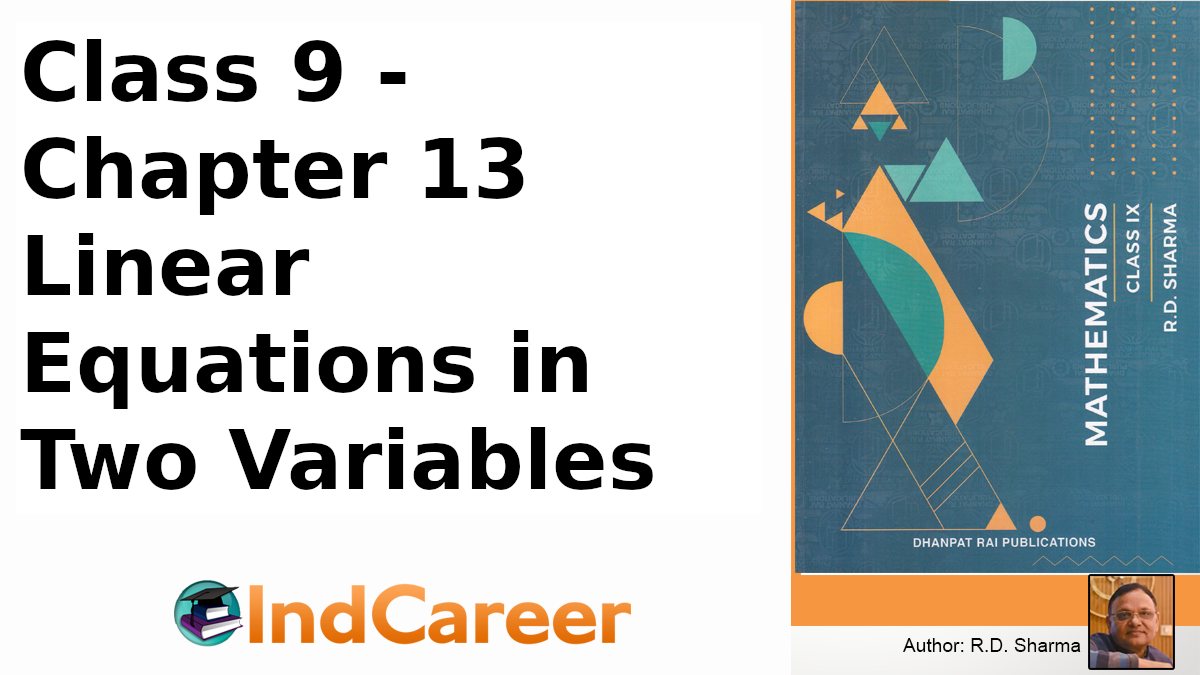Class 9: Maths Chapter 13 solutions. Complete Class 9 Maths Chapter 13 Notes.
Contents
RD Sharma Solutions for Class 9 Maths Chapter 13–Linear Equations in Two Variables
RD Sharma 9th Maths Chapter 13, Class 9 Maths Chapter 13 solutions
Exercise 13.1
Question 1: Express the following linear equations in the form ax + by + c = 0 and indicate the values of a, b and c in each case:
(i) -2x + 3y = 12 (ii) x – y/2 – 5 = 0 (iii) 2x + 3y = 9.35
(iv) 3x = -7y (v) 2x + 3 = 0 (vi) y – 5 = 0
(vii) 4 = 3x (viii) y = x/2
Solution:
(i) Given equation, -2x + 3y = 12
Or – 2x + 3y – 12 = 0
Comparing the given equation with ax + by + c = 0
We get, a = – 2; b = 3; c = -12
(ii) Given equation, x – y/2 – 5= 0
Comparing the given equation with ax + by + c = 0 ,
We get, a = 1; b = -1/2, c = -5
(iii) Given equation, 2x + 3y = 9.35
or 2x + 3y – 9.35 =0
Comparing the given equation with ax + by + c = 0
We get, a = 2 ; b = 3 ; c = -9.35
(iv) Given equation, 3x = -7y
or 3x + 7y = 0
Comparing the given equation with ax+ by + c = 0,
We get, a = 3 ; b = 7 ; c = 0
(v) Given equation, 2x + 3 = 0
or 2x + 0y + 3 = 0
Comparing the given equation with ax + by + c = 0,
We get, a = 2 ; b = 0 ; c = 3
(vi) Given equation, y – 5 = 0
or 0x + y – 5 = 0
Comparing the given equation with ax + by+ c = 0,
We get, a = 0; b = 1; c = -5
(vii) Given equation, 4 = 3x
or 3x + 0y – 4 = 0
Comparing the given equation with ax + by + c = 0,
We get, a = 3; b = 0; c = -4
(viii) Given equation, y = x/2
Or x – 2y = 0
Or x – 2y + 0 = 0
Comparing the given equation with ax + by + c = 0 ,
We get, a = 1; b = -2; c = 0
Question 2: Write each of the following as an equation in two variables:
(i) 2x = -3 (ii) y=3 (iii) 5x = 7/ 2 (iv) y = 3/2x
Solution:
(i) Given equation, 2x = -3
The above equation can be written in two variables as,
2x + 0y + 3 = 0
(ii) Given equation, y = 3
The above equation can be written in two variables as,
0 x + y – 3 = 0
(iii) Given equation, 5x = 7/2
The above equation can be written in two variables as,
5x + 0y – 7/2 = 0
or 10x + 0y – 7 = 0
(iv) Given equation, y = 3/2 x
The above equation can be written in two variables as,
2y = 3x
3x – 2y = 0
3x – 2y + 0 = 0
Question 3: The cost of ball pen is Rs 5 less than half of the cost of fountain pen. Write this statement as a linear equation in two variables.
Solution:
Let the cost of a fountain pen be y and cost of a ball pen be x.
According to the given statement,
x = y/2 − 5
or 2x = y – 10
or 2x – y + 10 = 0
Which is required linear equation.
Exercise 13.2
Question 1: Write two solutions for each of the following equations:
(i) 3x + 4y = 7
(ii) x = 6y
(iii) x + πy = 4
(iv) 2/3x – y = 4.
Solution:
(i) 3x + 4y =7 ….(1)
Step 1: Isolate above equation in y.
Subtract 3x from both the sides,
3x + 4y – 3x = 7 – 3x
4y = 7 – 3x
Divide each side by 4
y = 1/4 x (7 – 3x) ….(2)
Step 2: Find Solutions
Substituting x = 1 in (2)
y = 1/4 x (7 – 3) = 1/4 x 4 = 1
Thus x = 1 and y = 1 is the solution of 3x + 4y = 7
Again, Substituting x = 2 in (2)
y = 1/4 x (7 – 3 x 2) = 1/4 x 1 = 1/4
Thus x = 2 and y = 1/4 is the solution of 3x + 4y = 7
Therefore, (1, 1) and (2, 1/4) are two solution of 3x + 4y = 7.
(ii) Given: x = 6y
Substituting x =0 in the given equation,
0 = 6y
or y = 0
Thus (0,0) is one solution
Again, substituting x=6
6 = 6y
or y = 1
Thus, (6, 1) is another solution.
Therefore, (0, 0) and (6, 1) are two solutions of x = 6y.
(iii) Given: x + πy = 4
Substituting x = 0 ⇒ 0 + πy = 4 ⇒ y = 4/ π
Substituting y = 0 ⇒ x + 0 = 4 ⇒ x = 4
Therefore, (0, 4/ π) and (4, 0) are two solutions of x + πy = 4.
(iv) Given: 2/3 x – y = 4
Substituting x = 0 ⇒ 0 – y = 4 ⇒ y = -4
Substituting x = 3 ⇒ 2/3 × 3 – y = 4 ⇒ 2 – y = 4 ⇒ y = -2
Therefore, (0, -4) and (3, -2) are two solutions of 2/3 x – y = 4.
Question 2: Write two solutions of the form x = 0, y = a and x = b, y = 0 for each of the following equations :
(i) 5x – 2y =10
(ii) -4x + 3y =12
(iii) 2x + 3y = 24
Solution:
(i) Given: 5x – 2y = 10
Substituting x = 0 ⇒ 5 × 0 – 2y = 10 ⇒ – 2y = 10 ⇒ – y = 10/2 ⇒ y = – 5
Thus x =0 and y = -5 is the solution of 5x-2y = 10
Substituting y = 0 ⇒ 5x – 2 x 0 = 10 ⇒ 5x = 10 ⇒ x = 2
Thus x =2 and y = 0 is a solution of 5x – 2y = 10
(ii) Given, – 4x + 3y = 12
Substituting x = 0 ⇒ -4 × 0 + 3y = 12 ⇒ 3y = 12 ⇒ y = 4
Thus x = 0 and y = 4 is a solution of the -4x + 3y = 12
Substituting y = 0 ⇒ -4 x + 3 x 0 = 12 ⇒ – 4x = 12 ⇒ x = -3
Thus x = -3 and y = 0 is a solution of -4x + 3y = 12
(iii) Given, 2x + 3y = 24
Substituting x = 0 ⇒ 2 x 0 + 3y = 24 ⇒ 3y =24 ⇒ y = 8
Thus x = 0 and y = 8 is a solution of 2x+ 3y = 24
Substituting y = 0 ⇒ 2x + 3 x 0 = 24 ⇒ 2x = 24 ⇒ x =12
Thus x = 12 and y = 0 is a solution of 2x + 3y = 24
Question 3: Check which of the following are solutions of the equation 2x – y = 6 and which are not:
(i) ( 3 , 0 ) (ii) ( 0 , 6 ) (iii) ( 2 , -2 ) (iv) (√3, 0) (v) (1/2 , -5 )
Solution:
(i) Check for (3, 0)
Put x = 3 and y = 0 in equation 2x – y = 6
2(3) – (0) = 6
6 = 6
True statement.
⇒ (3,0) is a solution of 2x – y = 6.
(ii) Check for (0, 6)
Put x = 0 and y = 6 in 2x – y = 6
2 x 0 – 6 = 6
-6 = 6
False statement.
⇒ (0, 6) is not a solution of 2x – y = 6.
(iii) Check for (2, -2)
Put x = 0 and y = 6 in 2x – y = 6
2 x 2 – (-2) = 6
4 + 2 = 6
6 = 6
True statement.
⇒ (2,-2) is a solution of 2x – y = 6.
(iv) Check for (√3, 0)
Put x = √3 and y = 0 in 2x – y = 6
2 x √3 – 0 = 6
2 √3 = 6
False statement.
⇒(√3, 0) is not a solution of 2x – y = 6.
(v) Check for (1/2, -5)
Put x = 1/2 and y = -5 in 2x – y = 6
2 x (1/2) – (-5) = 6
1 + 5 = 6
6 = 6
True statement.
⇒ (1/2, -5) is a solution of 2x – y = 6.
Question 4: If x = -1, y = 2 is a solution of the equation 3x + 4y = k, find the value of k.
Solution:
Given, 3 x + 4 y = k
(-1, 2) is the solution of 3x + 4y = k, so it satisfy the equation.
Substituting x = -1 and y = 2 in 3x + 4y = k, we get
3 (– 1 ) + 4( 2 ) = k
– 3 + 8 = k
k = 5
The value of k is 5.
Question 5: Find the value of λ, if x = –λ and y = 5/2 is a solution of the equation x + 4y – 7 = 0
Solution:
Given, (-λ, 5/2) is a solution of equation 3x + 4y = k
Substituting x = – λ and y = 5/2 in x + 4y – 7 = 0, we get
– λ + 4 (5/2) – 7 =0
-λ + 10 – 7 = 0
λ = 3
Question 6: If x = 2 α + 1 and y = α -1 is a solution of the equation 2x – 3y + 5 = 0, find the value of α.
Solution:
Given, (2 α + 1, α – 1 ) is the solution of equation 2x – 3y + 5 = 0.
Substituting x = 2 α + 1 and y = α – 1 in 2x – 3y + 5 = 0, we get
2(2 α + 1) – 3(α – 1 ) + 5 = 0
4 α + 2 – 3 α + 3 + 5 = 0
α + 10 = 0
α = – 10
The value of α is -10.
Question 7: If x = 1 and y = 6 is a solution of the equation 8x – ay + a^2 = 0, find the values of a.
Solution:
Given, ( 1 , 6 ) is a solution of equation 8x – ay + a^2 = 0
Substituting x = 1 and y = 6 in 8x – ay + a^2 = 0, we get
8 x 1 – a x 6 + a^2 = 0
⇒ a^2 – 6a + 8 = 0 (quadratic equation)
Using quadratic factorization
a^2 – 4a – 2a + 8 = 0
a(a – 4) – 2 (a – 4) = 0
(a – 2) (a – 4)= 0
a = 2, 4
Values of a are 2 and 4.
Exercise 13.3
Question 1: Draw the graph of each of the following linear equations in two variables:
(i) x + y = 4 (ii) x – y = 2 (iii) -x + y = 6
(iv) y = 2x (v) 3x + 5y = 15 (vi) x/2 − y/3 = 2
(vii) (x−2)/3 = y – 3 (viii) 2y = -x +1
Solution:
(i) Given : x + y = 4
or y = 4 – x,
Find values of x and y:
Putting x = 0 ⇒ y = 4
Putting x = 4 ⇒ y = 0
Graph:
Mark points (0, 4) and (4, 0) on the graph and join them.
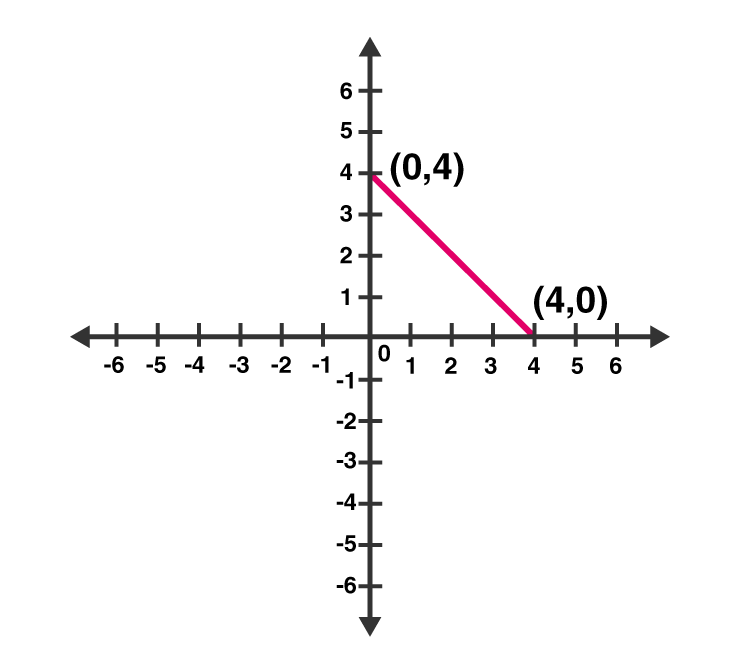
(ii) Given: x – y = 2
So, y = x – 2
Putting x = 0 ⇒ y = – 2
Putting x = 2 ⇒ y = 0
Graph:
Mark points (0, -2) and (2, 0) on the graph and join them.
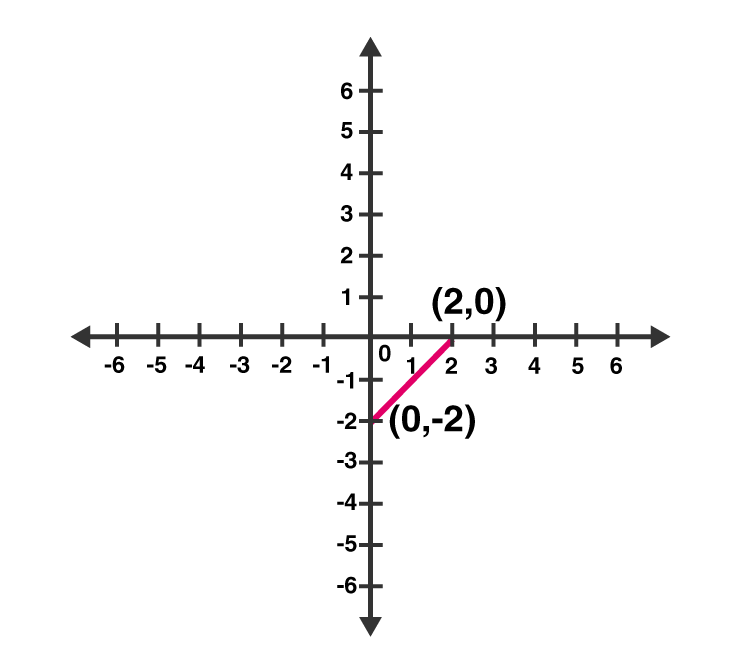
(iii) Given: – x + y = 6
So, y = 6 + x
Putting x = 0 ⇒ y =6
Putting x = -6 ⇒ y = 0
Graph:
Mark points (0, 6) and (-6, 0) on the graph and join them.
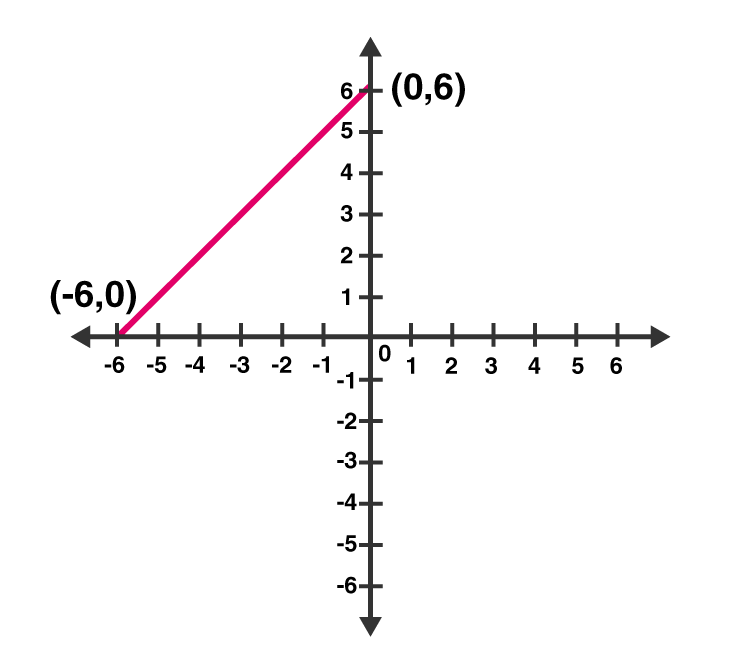
(iv) Given: y = 2x
Put x = 1 ⇒ y = 2
Put x = 3 ⇒ y = 6
Graph:
Mark points (1, 2) and (3, 6) on the graph and join them.

(v) Given: 3x + 5y = 15
Or 5y = 15 – 3x
Putting x = 0 ⇒ 5y = 15 ⇒ y =3
Putting x = 5 ⇒ 5y = 0 ⇒ y = 0
Graph:
Mark points (0, 3) and (5, 0) on the graph and join them.
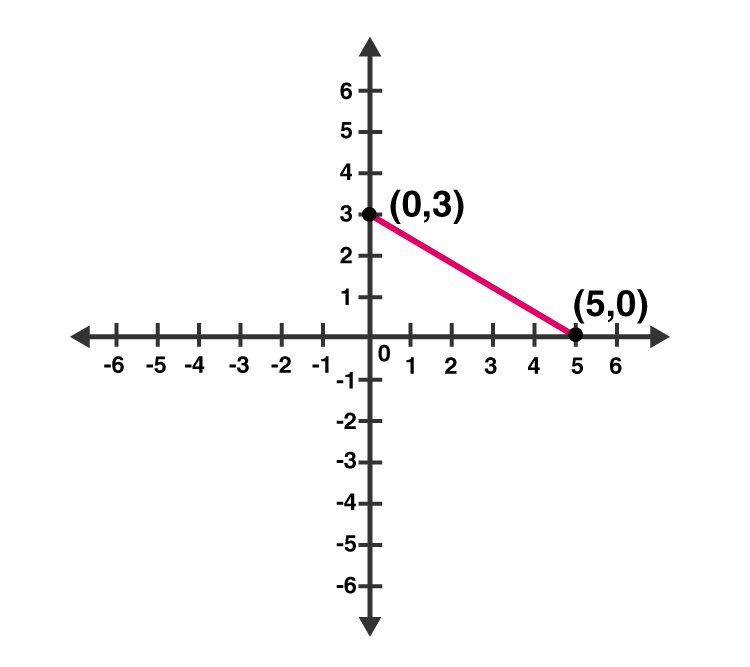
(vi) Given: x/2 – y/3 = 2
3x – 2y = 12
y = (3x–12)/2
Putting x = 0 ⇒ y = -6
Putting x = 4 ⇒ y = 0
Graph:
Mark points (0, -6) and (4, 0) on the graph and join them.
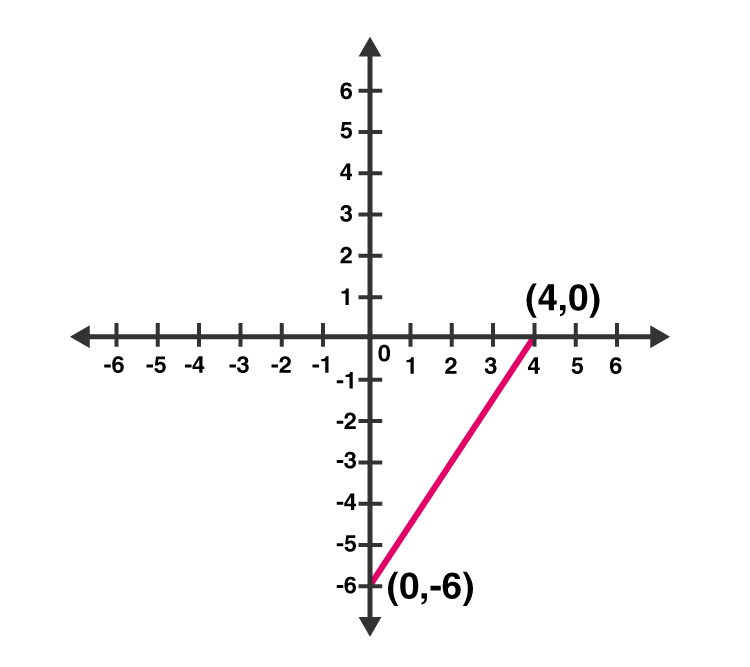
(vii) Given: (x −2)/3 = y − 3
x – 2 = 3(y – 3)
x – 2 = 3y – 9
x = 3y – 7
Now, put x = 5 in x = 3y – 7
y = 4
Putting x = 8 in x = 3y – 7,
y = 5
Graph:
Mark points (5, 4) and (8, 5) on the graph and join them.

(viii) Given: 2y = – x +1
2y = 1 – x
Now, putting x = 1 in 2y = 1 – x, we get;
y = 0
Again, putting x = 5 in 2y = 1 – x, we get;
y = -2
Graph:
Mark points (1, 0) and (5, -2) on the graph and join them.
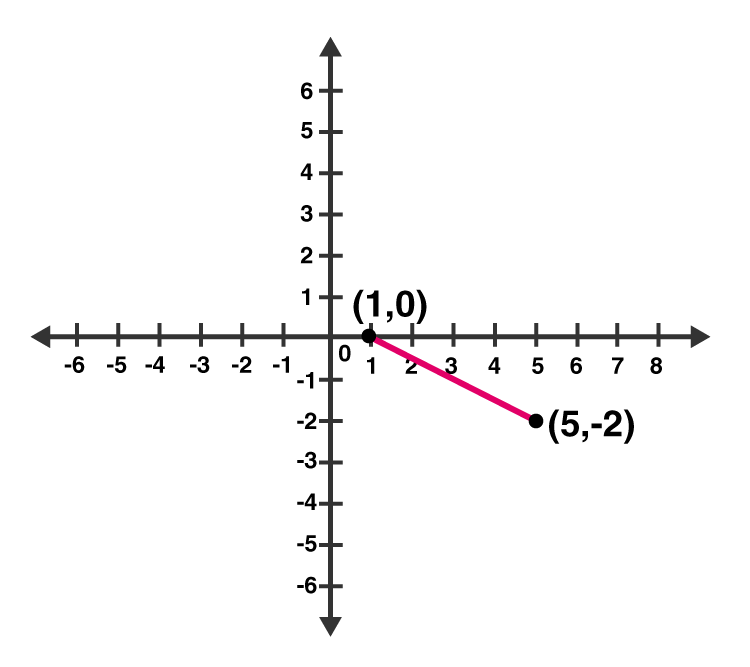
Question 2: Give the equations of two lines passing through (3, 12). How many more such lines are there, and why?
Solution:
Since a = 3 and b = 12 is the solution of required equations. So we have to find the set of any two equations which satisfy this point.
Consider 4a – b = 0 and 3a – b + 3 = 0 set of lines which are passing through (3, 12).
We know, infinite lines can be pass through a point.
So, there are infinite lines passing through (3, 12).
Question 3: A three-wheeler scooter charges Rs 15 for first kilometer and Rs 8 each for every subsequent kilometer. For a distance of x km, an amount of Rs y is paid. Write the linear equation representing the above information.
Solution:
Let, total fare for covering the distance of ‘x’ km is given by Rs y
As per the given statement;
y = 15 + 8(x – 1)
y = 15 + 8x – 8
y = 8x + 7
Above equation represents the linear equation for the given information.
Question 4: A lending library has a fixed charge for the first three days and an additional charge for each day thereafter. Aarushi paid Rs 27 for a book kept for seven days. If fixed charges are Rs x and per day charges are Rs y. Write the linear equation representing the above information.
Solution:
Aarushi paid Rs 27, of which Rs. x for the first three days and Rs. y per day for 4 more days is given by
x + (7 – 3) y = 27
x + 4y = 27
Above equation represents the linear equation for the given information.
Question 5: A number is 27 more than the number obtained by reversing its digits. lf its unit’s and ten’s digit are x and y respectively, write the linear equation representing the statement.
Solution:
Given: The original number is 27 more than the number obtained by reversing its digits
The given number is in the form of 10y + x.
Number produced by reversing the digits of the number is 10x + y.
As per statement:
10y + x = 10x + y + 27
10y – y + x – 10x = 27
9y – 9x = 27
9 (y – x) = 27
y – x = 3
x – y + 3 = 0
Above equation represents the required linear equation.
Question 6: The Sum of a two digit number and the number obtained by reversing the order of its digits is 121. If units and ten’s digit of the number are x and y respectively, then write the linear equation representing the above statement.
Solution:
As per the statement given, the number is 10y + x.
On reversing the digits of the number, we get, 10x + y
Sum of the two numbers is 121. (Given)
10y + x + 10x + y = 121
11x + 11y = 121
x + y = 11
Which represents the required linear equation.
Question 7: Plot the Points (3, 5) and (-1, 3) on a graph paper and verify that the straight line passing through the points, also passes through the point (1, 4).
Solution:
Plot points (3, 5), (-1, 3) and (1, 4) on a graph.
Let A(1, 4), B(3, 5) and C(-1, 3)
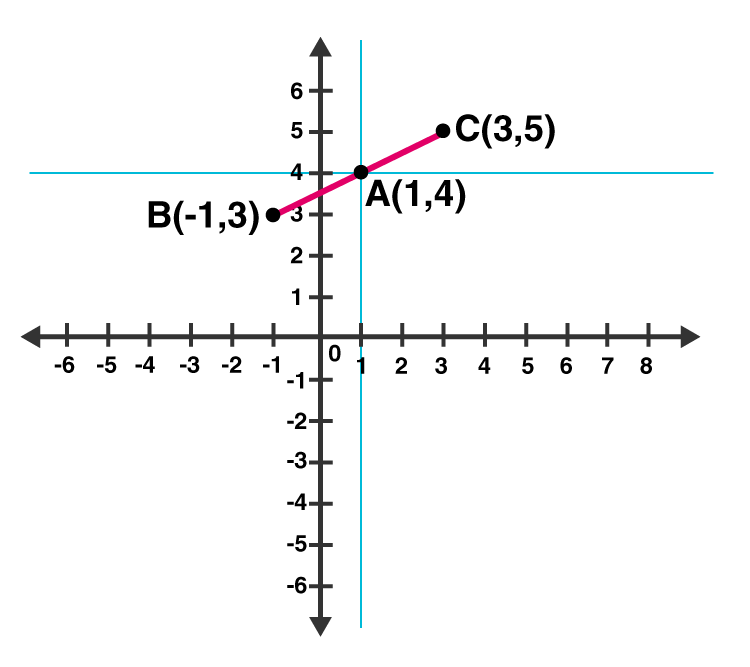
From above graph, we can see that, Point A (1, 4) is already plotted on the graph, and a point of intersection of two intersecting lines.
Hence, it is proved that the straight line passing through (3, 5) and (-1, 3) and also passes through A (1, 4).
Question 8: From the choices given below, choose the equations whose graph is given in figure.
(i) y = x (ii) x + y = 0 (iii) y = 2x (iv) 2 + 3y = 7x
Solution:
From graph, co-ordinates (1, -1) and (-1, 1) are solutions of one of the equations.
We will put the value of all the co-ordinates in each equation and check which equation satisfy them.
(i) y = x
Put x = 1 and y = -1 ,
Thus, 1 ≠ -1
L.H.S ≠ R.H.S
Putting x = -1 and y = 1 ,
-1 ≠ 1
L.H.S ≠ R.H.S
Therefore, y = x does not represent the graph in the given figure.
(ii) x + y = 0
Putting x = 1 and y = -1 ,
⇒ 1 + (-1) = 0
⇒ 0 = 0
L.H.S = R.H.S
Putting x = -1 and y = 1 ,
(-1) + 1 = 0
0 = 0
L.H.S = R.H.S
Thus, the given solutions satisfy this equation.
(iii) y = 2x
Putting x = 1 and y = -1
-1 = 2 (Not True)
Putting x = -1 and y = 1
1 = -2 (Not True)
Thus, the given solutions does not satisfy this equation.
(iv) 2 + 3y = 7x
Putting x = 1 and y = -1
2 – 3 = 7
-1 = 7 (Not true)
Putting x = -1 and y = 1
2 + 3 = -7
5 = -7 (Not True)
Thus, the given solutions does not satisfy this equation.
Question 9: From the choices given below, choose the equation whose graph is given fig:
(i) y = x + 2 (ii) y = x – 2 (iii)y = – x + 2 (iv) x + 2y = 6
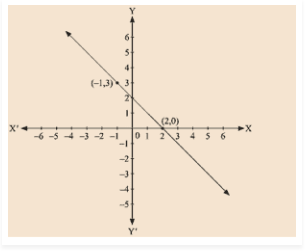
Solution:
Given: (-1, 3) and (2, 0) are the solution of one of the following given equations.
Check which equation satisfy both the points.
(i) y = x + 2
Putting, x = -1 and y = 3
3 ≠ – 1 + 2
L.H.S ≠ R.H.S
Putting, x = 2 and y = 0
0 ≠ 4
L.H.S ≠ R.H.S
Thus, this solution does not satisfy the given equation.
(ii) y = x – 2
Putting, x = -1 and y = 3
3 ≠ – 1 – 2
L.H.S ≠ R.H.S
Putting, x = 2 and y = 0
0 = 0
L.H.S = R.H.S
Thus, the given solutions does not satisfy this equation completely.
(iii) y = – x + 2
Putting, x = – 1 and y = 3
3 = – ( – 1 ) + 2
L.H.S = R.H.S
Putting x = 2 and y = 0
0 = -2 + 2
0 = 0
L.H.S = R.H.S
Therefore, (0, 2) and (-1,3) satisfy this equation.
Hence, this is the graph for equation y = -x + 2 .
(iv) x + 2y = 6
Putting, x = – 1 and y = 3
-1 + 2(3) = 6
-1 + 6 = 6
5 = 6
L.H.S ≠ R.H.S
Putting x = 2 and y = 0
2 + 2(0) = 6
2 = 6
L.H.S ≠ R.H.S
Thus, this solution does not satisfy the given equation.
Question 10 : If the point (2, -2) lies on the graph of linear equation, 5x + ky = 4, find the value of k.
Solution:
Point (2,-2) lies on the given linear equation, which implies (2, -2) satisfy this equation 5x + ky = 4.
Now, putting x = 2 and y = -2 in 5x + ky = 4
5 × 2 + ( -2 ) k = 4
10 – 2k = 4
2k = 10 – 4
2k = 6
k = 6/2 = 3
The value of k is 3.
Exercise 13.4
Question 1: Give the geometric representations of the following equations
(a) on the number line (b) on the Cartesian plane:
(i) x = 2 (ii) y + 3 = 0 (iii) y = 3 (iv) 2x + 9 = 0 (v) 3x – 5 = 0
Solution:
(i) x = 2
The representation of equation on the number line:

The representation of equation on the Cartesian plane:
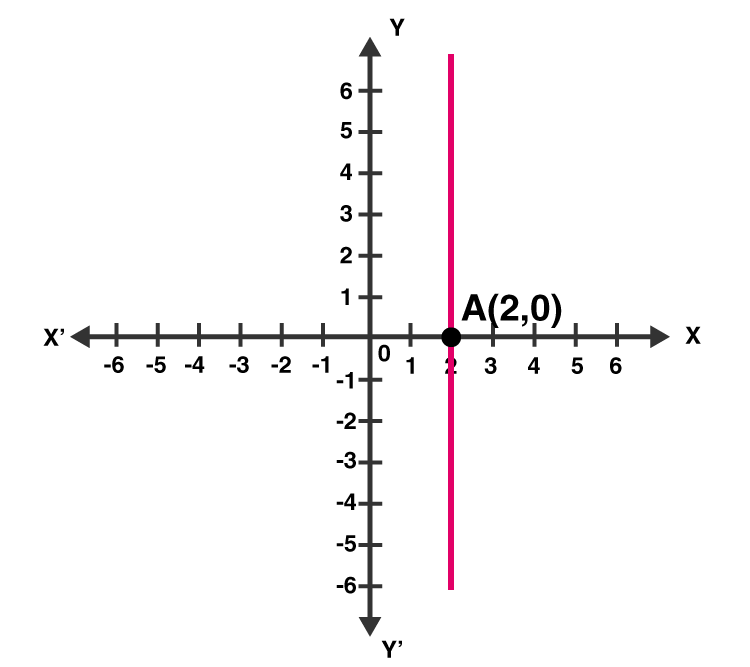
(ii) y + 3 = 0
or y = -3
The representation of equation on the number line:

The representation of equation on the Cartesian plane:
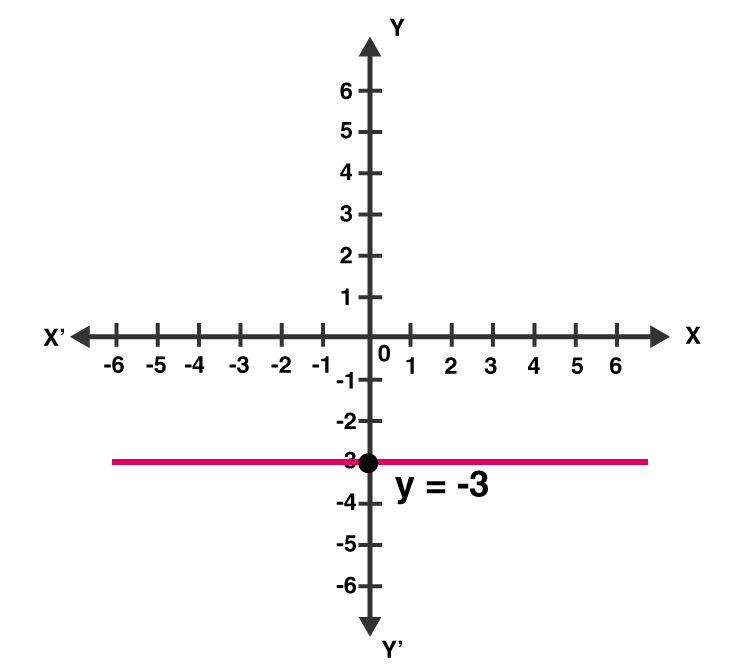
(iii) y = 3
The representation of equation on the number line:

The representation of equation on the Cartesian plane:
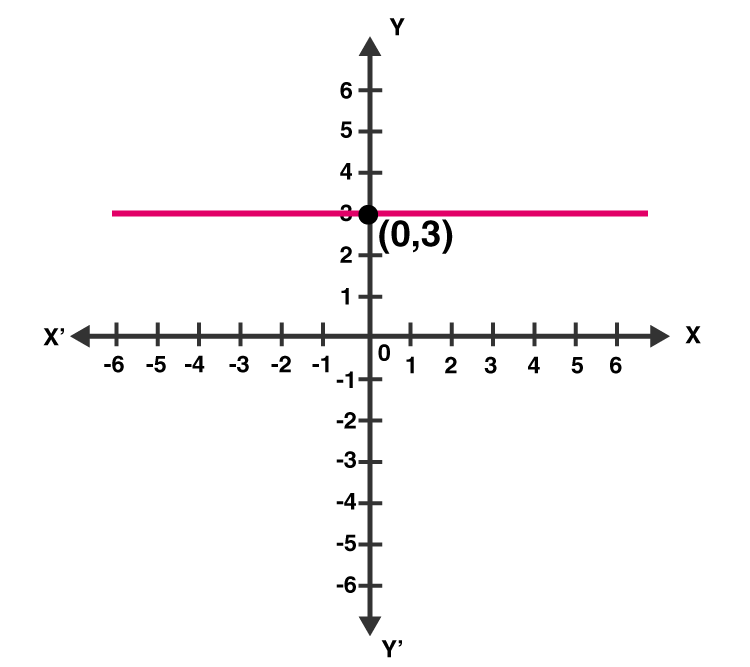
(iv) 2x + 9 = 0
or x = -9/2
The representation of equation on the number line:

The representation of equation on the Cartesian plane:
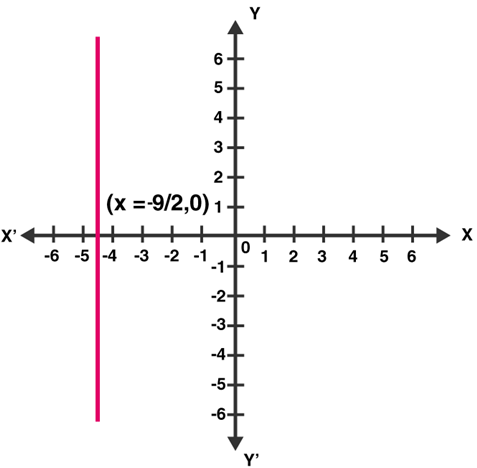
(v) 3x – 5 = 0
or x = 5/3
The representation of equation on the number line:

The representation of equation on the Cartesian plane:
Question 2 : Give the geometrical representation of 2x + 13 = 0 as an equation in
(i) one variable (ii) two variables
Solution:
2x + 13 = 0
(i) Isolate given equation in x
Subtract 13 from both the sides
2x + 13 – 13 = 0 – 13
2x = -13
Divide each side by 2
x = -13/2 = -6.5
Which is an equation in one variable.

(ii) 2x + 13 = 0 can be written as 2x + 0y + 13 = 0
The representation of the solution on the Cartesian plane: A line parallel to y axis passing through the point (-13/2 , 0):
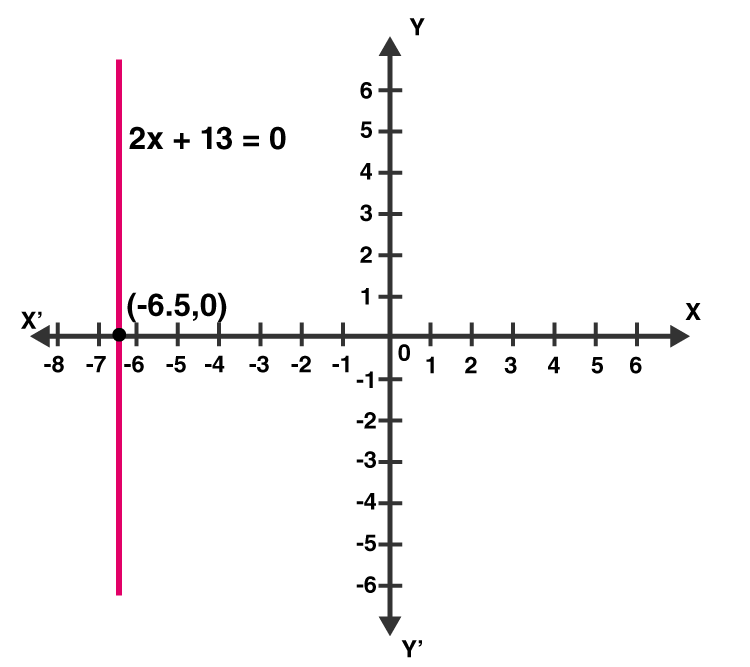
Exercise VSAQs Page No: 13.32
Question 1: Write the equation representing x-axis.
Solution: y = 0
Question 2: Write the equation representing y-axis.
Solution: x = 0
Question 3: Write the equation of a line passing through the point (0, 4) and parallel to x-axis.
Solution: Here, x-coordinate is zero and y-coordinate is 4, so equation of line passing through the point (0, 4) is y = 4.
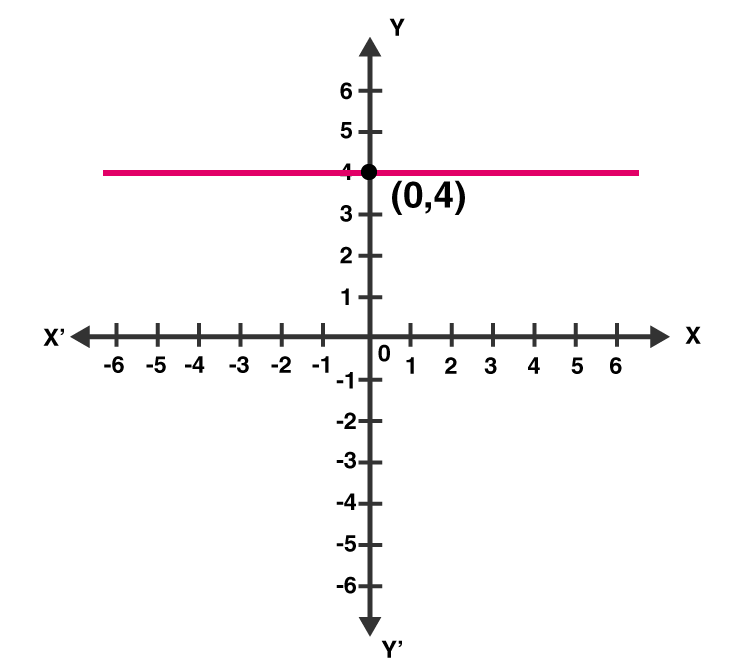
Question 4: Write the equation of a line passing through the point (3, 5) and parallel to x-axis.
Solution: Here x-coordinate = 3 and y-coordinate = 5
Since required line is parallel to x-axis, so equation of line is y = 5.
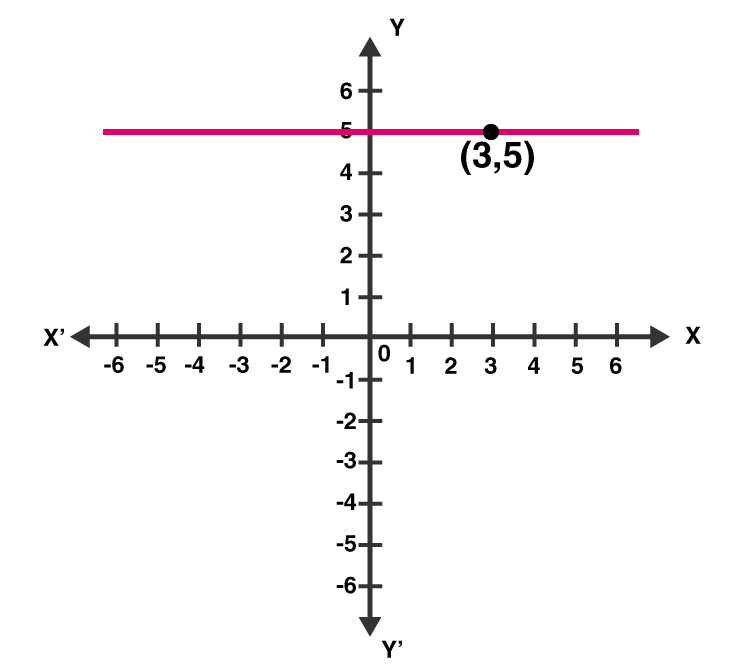
Question 5: Write the equation of a line parallel to y-axis and passing through the point (-3, -7)
Solution:
Here x-coordinate = -3 and y-coordinate = -7
Since required line is parallel to y-axis, so equation of line is x = -3.

RD Sharma Solutions for Class 9 Maths Chapter 13: Download PDF
RD Sharma Solutions for Class 9 Maths Chapter 13–Linear Equations in Two Variables
Download PDF: RD Sharma Solutions for Class 9 Maths Chapter 13–Linear Equations in Two Variables PDF
Chapterwise RD Sharma Solutions for Class 9 Maths :
- Chapter 1–Number System
- Chapter 2–Exponents of Real Numbers
- Chapter 3–Rationalisation
- Chapter 4–Algebraic Identities
- Chapter 5–Factorization of Algebraic Expressions
- Chapter 6–Factorization Of Polynomials
- Chapter 7–Introduction to Euclid’s Geometry
- Chapter 8–Lines and Angles
- Chapter 9–Triangle and its Angles
- Chapter 10–Congruent Triangles
- Chapter 11–Coordinate Geometry
- Chapter 12–Heron’s Formula
- Chapter 13–Linear Equations in Two Variables
- Chapter 14–Quadrilaterals
- Chapter 15–Area of Parallelograms and Triangles
- Chapter 16–Circles
- Chapter 17–Construction
- Chapter 18–Surface Area and Volume of Cuboid and Cube
- Chapter 19–Surface Area and Volume of A Right Circular Cylinder
- Chapter 20–Surface Area and Volume of A Right Circular Cone
- Chapter 21–Surface Area And Volume Of Sphere
- Chapter 22–Tabular Representation of Statistical Data
- Chapter 23–Graphical Representation of Statistical Data
- Chapter 24–Measure of Central Tendency
- Chapter 25–Probability
About RD Sharma
RD Sharma isn’t the kind of author you’d bump into at lit fests. But his bestselling books have helped many CBSE students lose their dread of maths. Sunday Times profiles the tutor turned internet star
He dreams of algorithms that would give most people nightmares. And, spends every waking hour thinking of ways to explain concepts like ‘series solution of linear differential equations’. Meet Dr Ravi Dutt Sharma — mathematics teacher and author of 25 reference books — whose name evokes as much awe as the subject he teaches. And though students have used his thick tomes for the last 31 years to ace the dreaded maths exam, it’s only recently that a spoof video turned the tutor into a YouTube star.
R D Sharma had a good laugh but said he shared little with his on-screen persona except for the love for maths. “I like to spend all my time thinking and writing about maths problems. I find it relaxing,” he says. When he is not writing books explaining mathematical concepts for classes 6 to 12 and engineering students, Sharma is busy dispensing his duty as vice-principal and head of department of science and humanities at Delhi government’s Guru Nanak Dev Institute of Technology.
